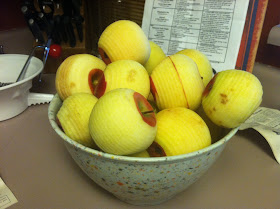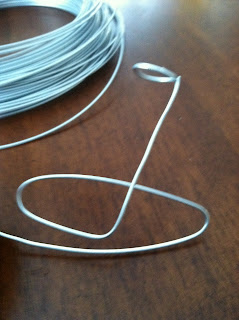I just started canning last year and find it so much fun. It is a lot of work but worth it to have healthy and chemical free stuff for your family to eat. This tutorial is a method used so that there is no waste from the apples.
Get your supplies ready:
- (7) Quart Jars with self sealing lids and screw rings - sanitize in dishwasher prior to using
- (3 or 4) Pint Jars with self sealing lids and screw rings - sanitize in dishwasher prior to using
- Apple peeler (the crank handle kind are easy and fast to use)
- Jar grabber (to pick up the hot jars)
- Lid lifter (has a magnet to pick the lids out of the boiling
water where you sanitize them
- Jar funnel
- At least 1 large pot to blanch the apples
- Large spoons and ladles
- 1 Water Bath Canner (a huge pot with a lifting rack to sanitize
the jars of
apple after
filling)
You CAN use a
large pot instead, but the canners are deeper, and have a rack
top
make lifting the jars out easier. If you plan on canning every
year,
they're worth the investment
- Food mill
- Blender
- Butter knife
Gather your ingredients that you will need
- Approximately 20 lbs of Apples, ask when you buy them for a good baking apple
- Cinnamon
- Nutmeg
- Ground or whole cloves
- 3 cups of sugar
- Lots of water
I am going to lay out the steps in order, so just follow the steps straight down. If you have the multi-tasking gene in the kitchen then more power to you. After you go through the process once you will see that there are several of these things that you can be doing at once. But I will leave that to you.
Step 1: Wash the apples
Step 2: Peel and slice the apples (SAVE the peels and the cores)


Step 3: In stock pot (preferably with removable strainer/steamer) mix together one cup of sugar with 7 cups of water (double or triple the recipe to bring the water level above the strainer). Bring to gentle boil.
Step 4: Place about 6 cups of the sliced apples in the boiling water and blanch for 3 to 5 minutes.
Step 5: Remove apples from boiling syrup and ladle into jars using the funnel. Use smaller spoon to press the apples into the jars. Leave 1/2" head space.
Step 6: Spoon syrup into jar. Use a knife to slide down the side and remove any air bubbles. Adding more liquid as required to fill the jar and leave about 1/2" of head space.
Step 7: Wipe jar mouth clean from any debris with a clean towel. Place lid on jar and screw the cap tight. Repeat this process until all of your seven quart jars are full.
Step 8: Process the jars. Place all the jars in the canning rack and lower into the water. The water should come up to at least the neck of the jar. If the water covers the jar then that is ok too. Process the jars according to
Pickyourown.org based on your elevation and canner.
Step 9: Remove the jars from the canner and place on the counter over night. Check the jars the next day by pushing on the top. If you hear a pop and are able to push down then your jars did not process correctly. Repeat steps 7 and 8.
Step 10: To make the "No waste apple sauce" - Cut all cores into cubes, you can leave on the stems, seeds and everything. Place cores and peels in microwave safe flat casserole dish with lid (You might have to do this in several shifts depending on the size of your microwave and casserole).
Sprinkle apple debris with cinnamon, cloves, and allspice (Remember a little goes a long way). Pour a small amount of the syrup (used earlier) over the pan (about 1/2 cup). Microwave for 10-15 minutes until the apples are soft.
Step 11: Remove from microwave and place everything in the blender. Blend until smooth. You can add small amounts of syrup if you want, but make sure that it is not too runny.
Step 12: Place the blender concoction into the food mill and turn the mill so that the contents are being deposited in a bowl below. Use the mill plate with the smallest holes. Keep spinning until the mixture left in the top of the food mill is pretty much dry and really chunky. This process separates all the good stuff from the gross stuff. Repeat Steps 10 to 12 until all the cores and peels are used up.
Step 13: Spoon the apple sauce into the pint jars using the funnel. Place lid on jar and screw the cap tight.
Step 14: Process the jars according to Steps 8 and 9. Note: I did not sanitize the correct size jars in the first place, so I just improvised and used what I had sanitized already, but the this amount of apples will make four pint jars of apple sauce.
Now you should have 7 quart jars of apples and 4 pint jars of spiced apple sauce. Use the jars of apples for apple pies, apple crisp, pork chops, meat loaf, dump cake, muffins, ice cream topping, cobbler, apple cake, or any other thing that you can think of.
Enjoy the season.
Kara

























































